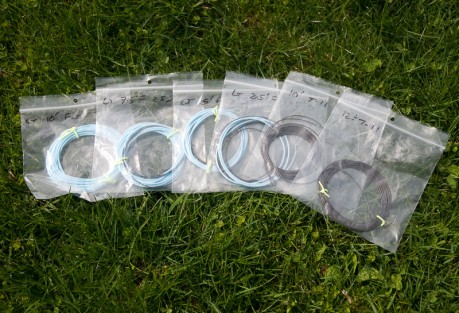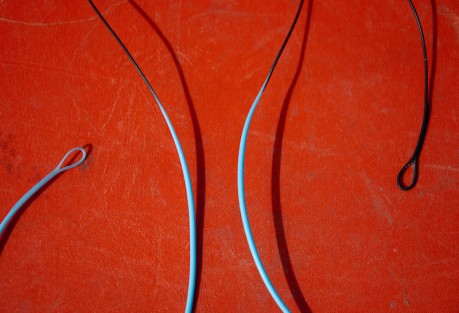Switch Rods
A switch rod is a cross between a single and two hand rod. Shorter than a dedicated two hand rod and
light as a single hand rod, switch rods can be cast and fished using both single hand and two hand
techniques. They are designed to roll cast, overhead cast, and handle the torsion placed on the rod
during change of direction casts (spey casts). Whether targeting trout, steelhead, salmon, or smallmouth
switch rods are versatile fishing tools perfectly suited to the wide variety of fishing situations encountered
throughout the Great Lakes Region.
Switch rods are typically 10.5 to 11.5 ft long with a longer top handle and bottom grip. The top grip is
about 1.5x the length of a single hand rod; bottom grip is about 4” and can be either fixed (part of the
rod) or removable. The longer handle and bottom grip allows the caster to instantly switch from casting
with one hand on the rod to two hands. The bottom grip also doubles as an extended fighting butt.
Using two-hands on the rod allows the caster to leverage more power from the rod blank. Two hands
pivoting around a fulcrum point between them can generate tremendous acceleration of the rod tip
loading the rod deeply into the blank for casting extra distance, larger flies or sink tips, and casting into
the wind.
Today, all of the major U.S. and European manufacturers offer a selection of switch rod models. Finding
an appropriate rod to match the size river, fishing techniques, and target species in the Great Lakes
region has never been easier.
Selecting a Line
For single hand overhead, roll, and spey casting with a switch rod a standard WF floating line is
recommended. The most versatile taper is a long belly WF floating line one to two line weights heavier
than the rod weight; a steelhead taper or extra distance taper works well. When overhead casting a
switch rod long distances with one or two hands a single hand shooting head one to two line weights
heavier than the rod weight is recommended.
While standard single hand lines perform fine on a switch rod for most methods of casting, they are not
recommended for two-handed spey casting. For two-hand spey casting with a floating line, a short belly
spey line or Scandinavian shooting head is best. However when casting sinking tips with larger and/or
heavier flies, a thick diameter Skagit shooting head works best. Select the line wt (often measured in
grains) based on the recommended line wt or grain wt. on the butt section of the rod. IF the grain wt is
not listed on the rod, either contact the manufacturer or visit their website.
When using a Skagit or Scandinavian shooting head, a general guideline to keep in mind is the ‘3 to 1’
rule; that is, maintain a 3:1 ratio of head length to rod length. For example: An 11-foot rod multiplied by
3 = 33 feet. A 23 ft Skagit head + 10 ft tip = 33 ft. NOTE: Not all combinations of head lengths + tip will
work out to a perfect 3:1 ratio. As long as the head is heavy enough to turn over the tip, anything within
+/- 3 feet will cast fine.
Reels
Choosing the correct size and weight reel to match to a switch rod is important. Large arbor reels that are
too light will not be able to properly balance the rod when casting heavier shooting heads with two hands.
Also, be aware that an 8wt Spey line is heavier than a single hand 8wt line. As a result the 8wt Spey line
has a larger diameter and therefore take up more space on a reel spool. Make sure the reel will
accommodate a spey line and at least 100yrds of backing. For most switch rods, a reel that will hold a
10wt standard single hand line is a good size; typically a reel that will hold an 8-10wt has a 4-4.25”
diameter. A sealed drag is a nice feature as well. It will stop the drag from icing up and free spooling
when fishing in the winter.
Leader,Material,and Sinking Tips
Tapered nylon leaders are best for indicator nymphing. Tapered floating Polyleaders or nylon leaders
approximately one rod in length are recommended when casting floating Spey lines. NOTE: Floating
shooting heads many require an even longer leader, perhaps 1.5+ length of the rod. When casting full
sinking lines or sink tips, a short length of level tippet material 3 to 5 feet is sufficient.
For streamer fishing or swinging flies, having a selection of various lengths and sink rate sinking tips will
allow for quick selection to match the depth and speed of the water.
Switch rods will easily handle 5 to 10 ft sink tips; after 10’ casting can become significantly more difficult
depending the sink rate of the tip and fly size. Tapered sinking leaders in 7.5’ to 10’ lengths are most
often used with floating spey lines or shooting heads. Heavier tungsten sink tips (T8-T14) are most
commonly used with Skagit lines.































